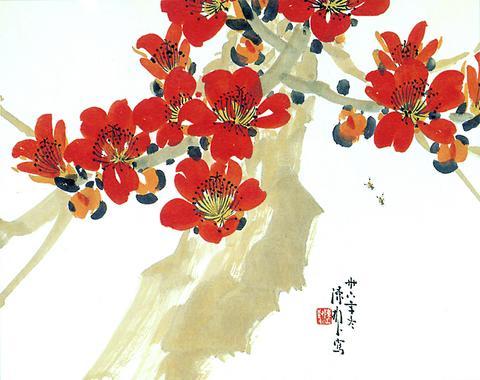Over the next five months, the Academia Sinica Lingnan Fine Arts Center (
Once used in reference to an area south of five mountain ranges that separate the Yangzi and Pearl river basins, the term Lingnan (
Established in the early 1900s when anti-foreign fervor was on the rise and the May the Fourth Movement was sowing the earliest seeds of Chinese nationalism, the Lingnan school was initially seen by many as little but another "alien" influenced challenge to traditional Chinese art.

PHOTO COURTESY OF ACADEMIA SINICA
The manner in which artists such as Chu Lien (居廉), who, after his death in 1904 was credited as being the movement's founding father, blended traditional Oriental themes such as mountains, insects and flowers with brush strokes and hues more commonly associated with Western art of the day, shocked Chinese traditionalists.
While their country was shunning foreign influence and looking inwards, artists of the Lingnan movement were taking the opposite path in a bid to develop and revise the long standardized guidelines that governed the way Chinese artists worked.
Nearly half a century after its founding, however, many of the scholars and artists who had originally poured scorn on the Lingnan school had changed their tunes and were hailing it as one of the most influential and significant styles of Chinese art.
The Lingnan movement is now held in such high regard that contemporary Lingnan artists are still creating works adhering to Chu Lien's guidelines and styles today and are held in equally high regard by their modern day peers.
Works by second generation Lingnan artists like Gao Chian-fu (
Featuring a selection of 50 works dating from the early 1900s to the mid-90s, the exhibition includes works by movement founder Chu, second generation Lingnan artist Gao Chien-fu, third generation Lingnan artists Kao Chi-feng (
It is not overly extensive, but the exhibition is well organized and gives visitors a good glimpse of the vivacious and multihued styles of celebrated Lingnan artists.
Exhibition notes:
What: Works from the Lingnan school (
Where: Academia Sinica Lingnan Fine Arts Center (
When: Now through Dec. 31.

June 23 to June 29 After capturing the walled city of Hsinchu on June 22, 1895, the Japanese hoped to quickly push south and seize control of Taiwan’s entire west coast — but their advance was stalled for more than a month. Not only did local Hakka fighters continue to cause them headaches, resistance forces even attempted to retake the city three times. “We had planned to occupy Anping (Tainan) and Takao (Kaohsiung) as soon as possible, but ever since we took Hsinchu, nearby bandits proclaiming to be ‘righteous people’ (義民) have been destroying train tracks and electrical cables, and gathering in villages

Dr. Y. Tony Yang, Associate Dean of Health Policy and Population Science at George Washington University, argued last week in a piece for the Taipei Times about former president Ma Ying-jeou (馬英九) leading a student delegation to the People’s Republic of China (PRC) that, “The real question is not whether Ma’s visit helps or hurts Taiwan — it is why Taiwan lacks a sophisticated, multi-track approach to one of the most complex geopolitical relationships in the world” (“Ma’s Visit, DPP’s Blind Spot,” June 18, page 8). Yang contends that the Democratic Progressive Party (DPP) has a blind spot: “By treating any

This year will go down in the history books. Taiwan faces enormous turmoil and uncertainty in the coming months. Which political parties are in a good position to handle big changes? All of the main parties are beset with challenges. Taking stock, this column examined the Taiwan People’s Party (TPP) (“Huang Kuo-chang’s choking the life out of the TPP,” May 28, page 12), the Democratic Progressive Party (DPP) (“Challenges amid choppy waters for the DPP,” June 14, page 12) and the Chinese Nationalist Party (KMT) (“KMT struggles to seize opportunities as ‘interesting times’ loom,” June 20, page 11). Times like these can

Swooping low over the banks of a Nile River tributary, an aid flight run by retired American military officers released a stream of food-stuffed sacks over a town emptied by fighting in South Sudan, a country wracked by conflict. Last week’s air drop was the latest in a controversial development — private contracting firms led by former US intelligence officers and military veterans delivering aid to some of the world’s deadliest conflict zones, in operations organized with governments that are combatants in the conflicts. The moves are roiling the global aid community, which warns of a more militarized, politicized and profit-seeking trend